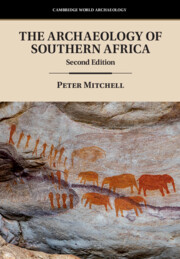Book contents
- Frontmatter
- Contents
- List of Figures
- List of Tables
- Acknowledgments
- 1 Introduction
- 2 Frameworks
- 3 Contexts
- 4 Origins
- 5 A Cognitive Revolution
- 6 Hunter-Gatherers of the Late Pleistocene
- 7 Archaeologies of the Pleistocene/Holocene Transition
- 8 Hunting, Gathering, Intensifying: Forager Histories in the Holocene before 2000bp
- 9 Taking Stock: Herders and Hunter-Gatherers
- 10 Farmers and Foragers: the First Millennium
- 11 Forming States: the Zimbabwe Culture and its Neighbours
- 12 Recent Farmers and Hunter-Gatherers in Southernmost Africa
- 13 Colonisation, Conquest, Resistance
- 14 Perspectives and Prospects
- Glossary
- References
- Index
7 - Archaeologies of the Pleistocene/Holocene Transition
Published online by Cambridge University Press: 15 May 2024
- Frontmatter
- Contents
- List of Figures
- List of Tables
- Acknowledgments
- 1 Introduction
- 2 Frameworks
- 3 Contexts
- 4 Origins
- 5 A Cognitive Revolution
- 6 Hunter-Gatherers of the Late Pleistocene
- 7 Archaeologies of the Pleistocene/Holocene Transition
- 8 Hunting, Gathering, Intensifying: Forager Histories in the Holocene before 2000bp
- 9 Taking Stock: Herders and Hunter-Gatherers
- 10 Farmers and Foragers: the First Millennium
- 11 Forming States: the Zimbabwe Culture and its Neighbours
- 12 Recent Farmers and Hunter-Gatherers in Southernmost Africa
- 13 Colonisation, Conquest, Resistance
- 14 Perspectives and Prospects
- Glossary
- References
- Index
Summary
Only for the transition between the Pleistocene and the Holocene (c. 13,000−8,000 years ago) do we have a rich and chronologically relatively well-controlled record with which to explore the impacts on hunter-gatherer populations of the profound ecological changes associated with the shift from glacial to interglacial climates and through which to consider their own creativity at such a time. Previous archaeological work developed competing hypotheses to explain the shifts from microlithic to non-microlithic and back to microlithic (of a different kind) technologies during this period. These are considered here, along with potential evidence for patterns of social relations similar to those found in Bushman groups of the ethnographic present. At the same time, fuller publication of work from Elands Bay Cave allows further discussion of the value of John Parkington’s pivotal concept of ‘place’ and of the merits and disadvantages of employing ‘industries’ as building blocks for thinking about the hunter-gatherer past. New fieldwork in Lesotho reinforces this, along with the importance of deepening the relation between theory and the process of archaeological excavation itself.
Keywords
- Type
- Chapter
- Information
- The Archaeology of Southern Africa , pp. 160 - 188Publisher: Cambridge University PressPrint publication year: 2024



